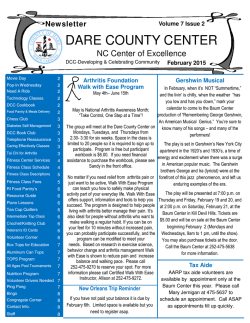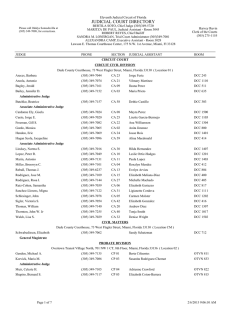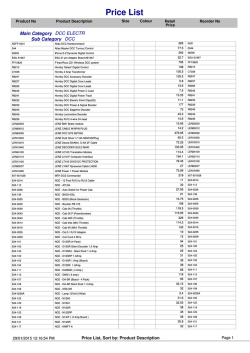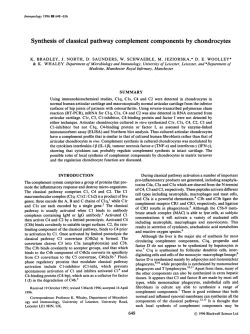
DCC Tumor Suppressor Gene Is Inactivated in Hematologic
From www.bloodjournal.org by guest on February 6, 2015. For personal use only. DCC Tumor Suppressor Gene Is Inactivated in Hematologic Malignancies Showing Monosomy 18 By Emilio Porfiri, Lorna M. Secker-Walker, A. Victor Hoffbrand. and J o h n F. Hancock DCC (deleted in colorectal cancer) is a candidate tumor suppressor gene recently identified on chromosome band 18q21. Loss of one DCC allele or decreasedDCC expression occurs in more than 70% of colorectalcancers, suggesting that DCC inactivation constitutes a critical event in the development of these tumors. Using polymerase chain reaction amplificationof cDNA, w e have studiedDCCexpression in bone marrow from 4 patients with leukemia (1 chronic myeloid leukemia-blastic crisis, case 1 ; 1 acute myeloid leukemia, case 2; 1 T-cell acute lymphoblastic leukemia [ALL], case 3; 1 6-cell ALL, case 4) showing loss of one DCC allele due to monosomy 18. W e also studied DCC expression in multiple control samples, including normal lymphocytes,normaltonsillar tissue, and leukemias without 18q abnormalities. Four primer pairs consistentlyamplified the predicted DCC sequences from cDNA prepared from all control samples. However, in samples with monosomy 18, DCC transcripts were either not detected (case 1) or detected at a very low level (cases 2, 3, and 4). Southern analysis showed no structural rearrangement of the remaining DCC locus in all leukemia samples. Thus, loss of DCC expressionwas demonstrated in associationwith loss of one DCCallele in all cases tested. These results suggest that, as for colorectal tumors, the inactivation of DCC can have a role in the developmentof hematologicmalignancies. 0 1993 by The American Society of Hematology. A region, has also been described in 38% of breast carcinomas, indicating that DCC inactivation may be important in the development of noncolonic tumors.R The predicted amino acid sequence suggests that DCC encodes a transmembrane phosphoprotein with several homologies to cell adhesion proteins of the neural cell adhesion molecule (N-CAM) family.3 Proteins of this group are involved in mediating cell to cell interactions and their roles include regulation of morphogenesis and immune recognition.' N-CAM proteins are expressed in lymphocytes, particularly natural killer (NK) cells, although they do not regulate their cytolytic activity." Although uncommon, the loss of one chromosome 18 has been described in acute myeloid leukemia (AML)." Recent publications suggest that this occurs as part of a complex karyotype showing multiple chromosomal abnormalities." Monosomy 18 has also been described in chronic myeloid leukemia (CML) in association with the t(9:22) translocation and rarely in acute lymphoblastic leukemia (ALL).'' We report here an investigation of the occurrence of DCC inactivation in hematologic malignancies showing monosomy 18. CCUMULATION of multiple genetic abnormalities causing activation of dominantly acting oncogenes and loss of function of tumor suppressor genes has been described in many human cancers. These observations have suggested a model of tumor development in which loss of tumor suppressor function and oncogene activation cooperate to trigger neoplastic transformation.' The paradigm of tumor suppressor gene inactivation envisages loss of both copies of the gene because a single, normal allele can be sufficient to exert tumor suppressor function,' although inactivation by dominant negative mutation may also occur.' Recent studies on colorectal cancer have identified a putative tumor suppressor gene, DCC (deleted in colorectal cancer), located on chromosome band I8q2 I .' Loss or alteration of one DCC allele due to 18q abnormalities occurs in more than 70% of colorectal tumors. DCC is expressed in most normal tissues and in a selection of noncolonic tumors, but 15 of 17 (88%) colon carcinoma cell lines and 13 of 16 (8 1%) colorectal carcinomas showed either absence or significant reduction of DCC t r a n ~ c r i p t i o n .A ~ . significant ~ decrease of DCC expression was also observed in CokFu' and SW4806 colon carcinoma cell lines, both showing loss of one DCC allele. Reintroduction of one normal chromosome 18 in these cell lines restored DCC expression and resulted in significant loss of t ~ m o r i g e n i c i t y .In ~ , ~addition, downregulation of DCC expression in Rat-1 cells, using an antisense RNA strategy, resulted in anchorage-independent growth, faster growth rate, and the cells gave rise to tumors in nude mice.7 Allelic loss of chromosome 18q, involving the DCC From the Department of Huematology. Ro.val Free Hospital School of Medicine, London. UK. Submitted October 2, 1992; accepted December 17. 1992. Supported by a grant to E.P. and J.F.H. from the Medical Research Coimcil, UK (Grant No. G9209270CA) and by a grant to L.M.S.-W from Kay Kendall Leukaemia A m d . Address reprint requests to Emilio Poi$ri, MD, ONYX Pharmaceuticals, 3031 Research Dr, Bldg A, Richmond, CA 94806. The publication costs of this article were defiayed in part by page charge payment. This article must therefore be hereby marked "advertisement" in accordance with 18 U.S.C. section I734 solelv to indicate this fact. 0 1993 by The American Society ofHematology. 0006-4971/93/8ll0-0007$3.00/0 2696 MATERIALS AND METHODS Clinical samples. Bone marrow samples from patients with leukemia and showing monosomy 18 were identified during routine diagnostic cytogenetics and stored frozen in liquid nitrogen or at -70°C. Tonsillar tissue, obtained from routine tonsillectomy, was snap frozen and stored in liquid nitrogen. Control lymphocytes were isolated from the peripheral blood of a healthy donor. In addition, 3 further samples of ALL and 1 sample of AML without loss o f D C C alleles were included in this study. Approval was obtained from the Institutional Review Board for these studies. Patients and volunteers were informed that blood or bone marrow samples were taken for research purposes and that their privacy would be protected. C>)togenefic analysis. Bone marrow or peripheral blood was cultured for 24 hours and prepared for cytogenetic analysis using standard techniques. Slides were made by edge flaming and were stained with trypsin giemsa.13 RNA and DNA pwificafion. Mononuclear cells were isolated by Fycoll-Hypaque (FH: Lymphoprep: Nyegaard, Oslo, Norway) density separation and lysed in guanidine-thiocyanate buffer. DNA and RNA were isolated after ultracentrifugation ofthe lysate on a CsCl c ~ s h i o n . ' ~ Reverse transcriptase-pol~merarasechain reaction (RT-PCR). Two micrograms of total RNA was reverse transcribed. The synthesis of Blood, Vol 81, No 10(May 15). 1993: pp2696-2701 From www.bloodjournal.org by guest on February 6, 2015. For personal use only. DCC INACTIVATION IN LEUKEMIA 2697 chain termination using modified T7 DNA polymerase (Sequenase; US Biochemical Corp, Cleveland, OH). Southern blot analysis. Five micrograms of genomic DNA was digested overnight with EcoRI or Pst I and electrophoresed in a 0.8% agarose gel. DNA was blotted onto a nylon membrane and hybridized for 18 hours at 65°C with the [~~-'*P]-labeled1.6-kb DCC cDNA probe.13Afterwards, hybridization blots were washed for 45 minutes at 65°C in 45 mmol/L NaCI, 4.5 mmol/L Na citrate, 1X Denhardt's solution, 0. I % SDS, and autoradiographed. Table 1 . Oligonucleotide Primers DCC1 DCC2 DCC3 DCC4 DCC5 Actin-1 Actin-2 G6PD-1 G6PD-2 5-gtcgac ATTTACCGATGCTCAGCTCGAAA 5'-TTCCGCCATGGTTTTTA A ATC A2 5'AGCCTCATTTTCAGCCACACA2 5'-gaattcCATCAACCTCTATATTCTGTTCTGTTC 5-atgcgaattcGTTCAAGGGAGGAGTCCAAC 5-TGCTATCCAGGCTGTGCTAT 5'-G ATGGAGTTG A AGGTAGTTT 5'-tagga ATTCATCATCATGGGTGCATCG' RESULTS 5-tagaagctTGTTTGCGGATGTCAGCCACTGT' We investigated DCC expression in bone marrow samples from 4 patients with leukemia, 1 with CML-blastic crisis (CML-BC) (case I), 1 with AML (case 2), I with T-ALL (case 3), and 1 with B-ALL (case 4), showing loss of chromosome 18q due to monosomy 18. These 4 samples were identified the first-strand cDNA was primed with random hexamers and performed at 42°C for 1 hour using 40 U of AMV reverse tran~criptase'~ among 48 CML-BCs, 120 AMLs, and 194 adult ALLs that (Boehringer, Mannheim, Germany). DNA polymerase I (Boehringer) showed karyotypic abnormalities during routine diagnostic was used for second-strand synthesis after RNase H treatment of the cytogenetics. The clinical characteristics of the patients and DNA-RNA hybrid.15One-twentieth of the cDNA was used for PCR the full cytogenetic data are summarized in Table 2. Monamplification in a 100 pL reaction mix including I00 pmol of each osomy 18 was detected in all cells karyotyped in 3 samples primer, 4 U of Taq polymerase (Amersham Int, Amersham, UK), (patients 1, 3, and 4), whereas loss of chromosome 18 was 0.2 mmol/L dNTPs, 10 mmol/L Tris-HCI, pH 8, 50 mmol/L KCI, detected only in 25% of the cells karyotyped in the sample 1.5 mmol/L MgClz, and 0.01%gelatin. Five oligonucleotide primers taken from patient 2. DCC expression was also studied in (2 sense and 3 antisense) were designed using the DCC cDNA senormal lymphocytes, normal tonsillar tissue, and 3 ALL quence,' a primer pair was designed using the /3 actin sequence,16 samples without chromosome 18 abnormalities. In addition, and a further primer pair, specific for glucose 6-phosphate dehydrogenase (G6PD) cDNA,17was also obtained (Table 1). The PCR rewe studied DCC expression in an AML sample with karyoaction was denatured at 95°C for 3 minutes, followed by 40 cycles typic loss of chromosome 18p and the centromeric region of ofdenaturation at 94°C for 1 minute, annealingat 58°C (DCCprimI8q, in which the telomeric region of 18q,including the DCC ers) or 57°C (actin primers and G6PD primers) for I minute, and locus. was translocated onto chromosome 17p, thus polymerization at 72°C for 2 to 4 minutes. The reaction was then der( I7)t( 17;18)(pI 1; q 12) (patient C2). held at 72°C for 10 minutes. One-tenth (10 p L ) of each PCR reaction In most normal tissues, including colonic mucosa, the was electrophoresed in an agarose gel stained with ethidium bromide expression of DCC is We therefore used RT-PCR to and the PCR products were visualized under UV light. In addition amplify DCC transcripts from cDNA. The primer pair DCC 1 1/100 of each PCR reaction was electrophoresed and blotted onto a DCC4 consistently amplified the predicted 1,114-bp DCC nylon membrane (Hybond N; Amersham) using vacuum blotting. fragment from cDNAs derived from tonsillar tissue and from Blots were hybridized at 65 "C for I8 hours with a 1.6-kbDCCcDNA the AML sample with chromosome 18q abnormalities not probe labeled by nick translation with [cx-~~PI~CTP." After hybridization, blots were washed for 60 minutes at 65°C in 15 mmol/L involving loss of the DCC locus (lanes C, and Cz, Fig 1). In NaC1, 1.5 mmol/L Na citrate, I X Denhardt's solution, 0. I % sodium addition, the same DCC fragment was amplified from cDNAs dodecyl sulfate (SDS) and autoradiographed. prepared from normal lymphocytes and 3 ALL samples The DCC cDNA probe used in these experiments was generated without alterations of chromosome 18 (data not shown). by PCR amplification from tonsillar cDNA using the primer pairs However, this primer pair failed to amplify the expected DCC DCCI-DCC3 and DCC2-DCC5 (Table 1) under the conditions specfragment from any of the cDNAs derived from tumor samples ified above. These primer pairs amplified overlapping DCC cDNA showing monosomy 18 (lanes 1, 2, 3, and 4, Fig 1). fragments spanning from nt 625 to nt 2250 of the DCC cDNA seThe primer pair DCC2-DCC3 was designed to amplify a quence. After digestion with the appropriate restriction enzymes, the 233-bp DCC cDNA fragment (Fig 2A) and was previously PCR products were ligated together, cloned into the pGEM 3Zf(+) vector (Promega Corp, Madison, WI), and sequenced by dideoxy used by Fearon et a13 to investigate the level of DCC expresSome of the primers carry extra nucleotides containing restriction sites to facilitate cloning (lower-case letters). Table 2. Clinical and Cytogenetic Characteristics of 4 Patients Whose Tumors Showed Deletion of Chromosome 18 ~ Case SexlAae Diagnosis 1 2 F/41 MI71 CML-myeloid blastic crisis MDS-AML 3 4 MI39 MI53 T-ALL B-ALL 44,XY.-2.-4,del(5)(ql3).+9,inv(9)(p22q22)c,del(l2)(pl 11,- 18[5]/ 44,XY .deI(7)(q22q34),-9,inv(9)c,del(l2)(q22q24),-16,add(17)(q25)[15] 45,XY,der(5)t(l;5)(qI 2;~15),der(8)t(8;9)(p21 ; q l 1)t(3;9)(pll ;q21).der(9)t(3;9)(pll; q l l ) , - 1 8 [ 9 ] 47,XY.+7,t(8;14)(q24;q32),t(9;12)(~22;q13),+12,-18[4]/48,XY,idem,+3[10] C,' F/24 AML 46,XX,t(6;9)(p23;q34),+8,der(17)t(l7;18)(pll;ql2),- 1 8 KaNOtVDe 45,XX,t(3;13)(~25;q13),t(9;22)(q34;ql 1),-18[11] * Clinical characteristics of a control patient (lanes C2, Figs 1 through 5) whose tumor showed abnormalities of chromosome 18q not involving DCC alleles. From www.bloodjournal.org by guest on February 6, 2015. For personal use only. 2698 PORFlRl ET AL A spanning nt 625 to nt 1738. could be amplified from the monosomy 18 tumors as two scparate fragments. The primer pair DCCI-DCC3 amplified the expected 594-bp fragment. from nt 625 to nt 1218. from all the control cDNAs (lanes C , and C?. Fig 3) and no PCR product was amplified from the cDNA of the monosomy I8 sample that gave no product with primer pair DCC2-DCC3 (lane I. Fig 3). A very low level of amplification was obtained in the remaining 3 monosomy 18 leukemia bone marrows (lanes 2. 3. and 4. Fig 3) that was detectable only by Southern blotting an aliquot of the PCR reactions. We next used primer pair DCC2-DCC4 to amplify a 753-bp DCC fragment, from nt 986 to nt 1738. The expected fragment was obtained from the control cDNAs (lanes C , and C 2 . Fig 4). but not from cDNAs derived from two monosomy 18 samples (lanes I and 4, Fig 4). This sequence was amplified only at low level from the remaining two monosomy 18 leukemia samples (lanes 2 and 3. Fig 4). To confirm the integrity of the RNA used to prepare the cDNAs. we performed RT-PCR experiments using a primer pair designed to amplify a @-actincDNA fragment of 446 bp (actin-I-actin-?, Table I ) . The expected @-actin cDNA sequence was consistently amplified, with equivalent efficiency. from all the control cDNAs and from all cDNAs derived from leukemia bone marrows showing monosomy 18 (Fig DCCl DCC2 DCC3 I I DCC4 I I nt 1 nt 2250 1114 bp M C 1 1 3 C p 2 4 Co 3000 bp1114bp- C cp 2 3 4 co 1114 bp- A D C C l DCC2 Fig 1. (A) The primers DCCl -DCC4 (Table 1) amplify a 1.114bp DCC fragment comprising nt 625 to nt 1738. (B)Agarose gel electrophoresis of the PCR products amplified using the primer pair DCCl -DCC4. Lane M, molecular size markers (size indicated alongside the gel); lane C,, control cDNA derived from tonsillar tissue: lane C, control cDNA derived from an AML sample without deletions of chromosome 18q21 (patient C, Table 2); lanes 1, 2, 3, and 4, cDNAs derived from leukemia samples with monosomy 1 8 (patients 1, 2, 3, and 4, Table 2); lane Co, no cDNA. (C) Southern blot analysis of the agarose gel presented in (B).The probe used for Southern blotting was a 1.6-kb DCC cDNA fragment generated as described in Materials and Methods. sion in normal tissues and in colon carcinoma cell lines.' Using this primer pair we could amplify the expected DCC fragment from control cDNAs. We could not amplify the 233-bp fragment from cDNA derived from one monosomy 18 sample (lane I , Fig 2) and we amplified the same fragment only at a very low level from the other 3 monosomy 18 cDNAs (lanes 2,3, and 4. Fig 2). To determine the sensitivity of this primer pair in detecting DCC mRNA, one of the control samples was diluted with H 2 0 before amplification. A signal equivalent to that seen in lanes 2, 3. and 4 of Fig 2 was obtained when the cDNA was diluted l:103. which is consistent with the DCC mRNA in these samples being reduced to 0.1% of the control (data not shown). The 233-bp DCC fragment amplified by the primer pair DCC2-DCC3 is a segment of the 1, I 14-bp fragment amplified by the primer pair DCCI-DCC4 from all control cDNAs. We therefore studied whether the rest of this DCC region, DCC4 I I 233bp ntl 233 DCC3 I I nt 2250 bP C 233 bp- c, 1 c2 2 3 4 co m -+ Fig 2. (A) The primers DCC2-DCC3 (Table 1) amplih a 233-bp DCCfragment comprising nt 986 to nt 1218. (B)Agarose gel electrophoresis of the PCR products amplified using the primer pair DCC2-DCC3. Lane M, molecular size marker (size indicated alongside the gel). Samples loaded as in Fig 1. (C) Southern blot analysis of the agarose gel presented in (B);the probe was as in Fig 1C. From www.bloodjournal.org by guest on February 6, 2015. For personal use only. DCC INACTIVATION IN LEUKEMIA 2699 DISCUSSION A DCCl DCC2 DCC3 I I DCC4 I I nt 1 nt 2250 5 9 4 bp C c1 1 c 2 2 3 4 c 0 The loss or significant decrease of DCC expression has been observed in more than 80% of colorectal cancers and colon carcinoma cell but abnormalities of DCC expression have not been reported previously in any noncolonic tumor. We were interested in the possibility that DCC inactivation may be involved in the development of hematologic malignancies with documented loss of one DCC allele and we therefore studied expression of DCC in a set of leukemias showing loss of one chromosome 18. Using RT-PCR. four primer pairs consistently amplified the predicted DCC sequences from cDNAs prepared from normal tonsillar tissue. normal lymphocytes. and leukemia samples without abnormalities of the DC'C loci. The same primer pairs failed to amplify any DCCtranscripts from cDNA prepared from one leukemia sample showing monosomy 18 (patient 1). In a further two monosomy 18 leukemia samples (patients 2 and 3). the primer pairs DCCI-DCC3 and DCC3-DCC4 amplified, although at a very low level. overlapping DCC fragments spanning nt 675 to nt 1738. This 1.1 14-bp region was amplified as a single fragment in all control cDNA by the primer pair DCCI-DCC4. but could not be amplified from the 2 monosomy 18 cDNAs. probably because of the low level of DCc'transcripts present in these samples. although a reduced 5 9 4 bp- A D C C l D C C 2 DCC3 Fig 3. (A) The primers DCCl -DCC3 (Table 1) amplify a 594-bp DCCfragment comprising nt 625 to nt 121 8. (B) Agarose gel electrophoresis of the PCR products amplified using the primer pair DCCl -DCC3. Lane M, molecular size marker (size indicated alongside the gel). Samples loaded as in Fig 1. (C) Southern blot analysis of the agarose gel presented in (B); the probe was as in Fig 1C. 5A). Furthermore, in similar RT-PCR studies, a primer pair specific for the G6PD cDNA amplified the expected 162-bp fragment from control cDNA and from all cDNAs prepared from the monosomy 18 samples (Fig 5B). The G6PD gene is a widely expressed housekeeping gene whose mRNA constitutes less than 0.1% of total mRNA of mammalian cells." Thus, an mRNA species, which is normally expressed at a very low level. was preserved in all cDNA preparations. indicating that the loss of DCC expression we detected in the monosomy 18 tumors was caused by a selective loss of DCC transcripts and was not due to general RNA degradat i on. Finally. we investigated whether there were any structural rearrangements in the remaining DCC locus to which the abnormalities of DCC expression could be related. Southern blot analysis using the 1.6-kb DCC cDNA showed I I EtnRI fragments in control and monosomy I8 samples. Similarly, no evidence of deletions or rearrangements of the D C C region were detected with Psf I genomic restriction. However, it should be emphasized that the probe used in this analysis is not a full-length cDNA and thus rearrangements outside the region investigated by this probe would not be detected. I I DCC4 I I nt 2 2 5 0 ntl 753 bp B M C i 1 C2 2 c2 2 3 4 C o 5 9 3 bp- C c1 1 3 4 co 753 bp- Fig 4. (A) The primers DCC2-DCC4 (Table 1) amplify a 753-bp DCC fragment comprising nt 9 8 6 to nt 1738. (B) Agarose gel electrophoresis of the PCR products amplified using the primer pair DCCP-DCC4. Lane M, molecular size marker (size indicated alongside the gel). Samples loaded as in Fig 1. (C) Southern blot analysis of the agarose gel presented in (B); the probe was as in Fig 1C. From www.bloodjournal.org by guest on February 6, 2015. For personal use only. PORFlRl ET AL 2700 B c1 1 c2 2 3 efficiency of the primer pair DCCI-DCC4 in this PCR reaction cannot be excluded. In the remaining monosomy 18 sample (patient 4). the primer pairs DCCl -DCC3 and DCC2-DCC3 generated a low level of amplification of DCC sequences spanning nt 625 to nt 1218, whereas the primer pairs DCCI-DCC4 and DCC2DCC4 failed to detect DCC transcripts. Because these primer pairs worked with comparable efficiency in control cDNAs. it is possible that a DC‘C mRNA lacking the DCC4 primer sequence was expressed in this tumor. This mRNA may represent a normal. alternative spliced form of the DCC mRNA or an aberrantly spliced mRNA resulting from mutation of a splice donor or acceptor site. Indeed. expression ofabnormal DCC mRNA has previously been described in a colon carcinoma in which an intronic point mutation generated a potential 3’ splice acceptor site.’ The low level ofDCCexpression detected in 3 monosomy 18 cDNAs (patients 2, 3, and 4) could have originated from the small fraction of normal hematopoietic cells present in the leukemia samples. Consistent with this view, the lowest RT-PCR signals were detected in samples from patients 3 and 4 in which the fraction of malignant cells was 95% and 98%. respectively. A stronger signal was detected in the leukemia sample taken from patient 2. whose bone marrow showed an 82% substitution with blasts. Interestingly. in this patient, loss of chromosome 18 was found in only 25% of the cells karyotyped. The significantly reduced RT-PCR signal detected in this sample argues that leukemic cells showing two apparently normal chromosome I8 were also expressing a low level of DCC and that submicroscopical alterations of the DCC loci affecting the expression of DCC may have been present in the majority of the leukemic cells. The sample that gave no signal with any primer pair was taken from a patient with CML-BC. Because this is a neoplastic transformation of a pluripotent stem cell. we would expect the blast and the nonblast cell population to be derived from the same clone. Therefore, this sample probably contained no normal cells, i Fig 5. (A) Agarose gel electrophoresis analysis of the PCR productsgenerated by using the primers actin-1 -actin-2 (Table 1). Samples loaded as in Fig 1. (B) Agarose gel electrophoresis analysis of the PCR productsgenerated by usingthe primers GGPD1-G6PD-2 (Table 1). Samples loaded as in Fig 1. which is consistent with the total absence of DCC message we observed. In the development of colorectal tumors. loss or alteration of DCC alleles occurs in 47% of late adenomas and in 73% of carcinomas.” Interestingly, in one of the monosomy I8 samples (patient I). loss ofchromosome I8 and. presumably. loss of DCCexpression were late events that took place during the evolution of a CML to blastic phase. Of the remaining three monosomy I8 samples. one was taken during the AML transformation of a myelodysplastic syndrome (patient 2). another during the lymphoblastic transformation of a lowgrade B lymphoma (patient 4). and the remaining sample was taken from a patient with chemotherapy-resistant ALL (patient 3). It is tempting to speculate that. as for colorectal carcinogenesis, DCC inactivation constituted a late event in leukemogenesis in at least 3 ofthese patients and contributed to tumor progression. In the 4 leukemia samples we studied. monosomy I8 and DCC inactivation were associated with other chromosomal abnormalities that cause genetic alterations known to play a critical role in leukemogenesis.” Current views regarding the molecular pathogenesis of cancer stress the necessity of multiple genetic abnormalities for tumor development.” Accordingly, loss of DCC function in leukemias showing monosomy I8 would constitute one of the steps contributing to neoplastic progression. In conclusion. our observations suggest, for the first time. the involvement of DCC inactivation in the development of hematologic malignancies. Further studies are needed to investigate the incidence of DCC inactivation in leukemias and lymphomas and to identify the molecular mechanism by which DCC may participate in the control of growth and/or differentiation of hematopoietic cells. ACKNOWLEDGMENT The authors thank Dr L. Foroni for helpful discussion and advice. From www.bloodjournal.org by guest on February 6, 2015. For personal use only. DCC INACTIVATION IN LEUKEMIA REFERENCES I . Marshall CJ: Tumor suppressor genes. Cell 46:3 13, I99 1 2. Kern SE, Pietenpol JA, Thiagalingam S, Seymour A, Kinzler KW, Vogelstein B: Oncogenic forms of p53 inhibit p53 regulated gene expression. Science 256327, 1992 3. Fearon ER, Cho KR, Nigro JM, Kern SE, Simons JW, Ruppert JM, Hamilton SR, Presinger AC, Thomas G, Kinzler KW, Vogelstein B Identification of a chromosome 189 gene that is altered in colorectal cancer. Science 247:49, 1990 4. Kikuchi-Yanoshita R, Konishi M, Fukunari H, Tanaka K, Miyaki M: Loss of expression of the DCC gene during progression of colorectal carcinomas in familial adenomatous polyposis and nonfamilial adenomatous polyposis patients. Cancer Res 52:3801, 1992 5. Tanaka K, Oshimura M, Kikuchi R, Seki M, Hayashi T, Miyaki M: Suppression of tumorigenicity in human colon carcinoma cells by introduction of normal chromosome 5 or 18. Nature 349:340, 1991 6. Goyette MC, Cho K, Fasching CL, Levy DB, Kinzler KW, Paraskeva C, Vogelstein B, Stanbridge EJ: Progression of colorectal cancer is associated with multiple tumor suppression gene defects but inhibition oftumorigenicity is accomplished by correction of any single defect via chromosome transfer. Mol Cell Biol 12: 1387, 1992 7. Narayanan R, Lawlor KG, Schaapveld RQJ, Cho KR, Vogelstein B, Bui-Vinh Tran P, Osborne MP, Telang NT: Antisense RNA to the putative tumor suppressor gene DCC transforms Rat-I fibroblasts. Oncogene 7553, 1992 8. Devilee P, van Vliet M, Kuipers-Dijkshoorn N, Pearson PL, Comelisse CJ: Somatic genetic changes on chromosome 18 in breast carcinomas: Is the DCC gene involved? Oncogene 6:3 11, 199 I 9. Edelman GM: Morphoregulatory molecules. Biochemistry 27: 3533, 1988 10. Lanier LL, Chang C, Azuma M, Ruitenberg JJ, Hemperly JJ, Phillips JH: Molecular and functional analysis of human natural killer cell-associatedadhesion molecules (N-CAM/CD56).J Immunol 146:4421, 1991 2701 1 I. Mitelman F Catalog of Chromosome Aberration in Cancer (ed 4). New York, NY, Liss, 1991, p 1341 12. Fenaux P, Jonveaux P, Quiquandon I, Lai JL, Pignon JM, Loucheux-Lefebvre MH, Bauters F, Berger R, Kerckaert J P P53 gene mutations in acute myeloid leukemia with 17p monosomy. Blood 78:1652, 1991 13. Secker-Walker LM, Cooke HMG, Browett PJ, Shippey CA, Norton JD, Coustan-Smith E, Hoffbrand AV: Variable Philadelphia breakpoints and potential lineage restriction of bcr rearrangement in acute lymphoblastic leukemia. Blood 72:784, 1988 14. Sambrook J, Fritsch EF, Maniatis T Molecular Cloning: A Laboratory Manual (ed 2). Cold Spring Harbor, NY, Cold Spring Harbor Laboratory, 1989 15. Gubler U, Hoffmann BJ: A simple and very efficient method for generating cDNA libraries. Gene 25:263, 1983 16. Nakajima-Iijima S, Hamada H, Reddy P, Takanuga T: Molecular structure of the human cytoplasmic &actin gene: Intraspecies homology of sequences in the introns. Proc Natl Acad Sci USA 82: 6133, 1985 17. Boehm T, Spillantini MG, Sofroniew MV, Surani MA, Rabbits TH: Developmentally regulated and tissue specific expression of mRNAs encoding the two alternative forms of the LIM domain oncogene rhombotin: Evidence for thymus expression. Oncogene 6: 695, 1991 18. Persico MG, Toniolo D, Nobile C, DUrso M, Luzzatto L cDNA sequences of human glucose 6-phosphate dehydrogenase cloned in pBR322. Nature 294:778, 1981 19. Vogelstein B, Fearon ER, Hamilton SR, Kern SE, Presinger AC, Leppert M, Nakamura Y,White R, Smits AMM, Bos J L Genetic alterations during colorectal tumour-development. N Engl J Med 319525, 1988 20. Sawyers CL, Denny CT, Witte ON: Leukemia and the disruption of normal hematopoiesis. Cell 64:337, 199I 2 I. Fearon ER, Vogelstein B: A genetic model for colorectal tumorigenesis. Cell 6 I :759, 1990 From www.bloodjournal.org by guest on February 6, 2015. For personal use only. 1993 81: 2696-2701 DCC tumor suppressor gene is inactivated in hematologic malignancies showing monosomy 18 E Porfiri, LM Secker-Walker, AV Hoffbrand and JF Hancock Updated information and services can be found at: http://www.bloodjournal.org/content/81/10/2696.full.html Articles on similar topics can be found in the following Blood collections Information about reproducing this article in parts or in its entirety may be found online at: http://www.bloodjournal.org/site/misc/rights.xhtml#repub_requests Information about ordering reprints may be found online at: http://www.bloodjournal.org/site/misc/rights.xhtml#reprints Information about subscriptions and ASH membership may be found online at: http://www.bloodjournal.org/site/subscriptions/index.xhtml Blood (print ISSN 0006-4971, online ISSN 1528-0020), is published weekly by the American Society of Hematology, 2021 L St, NW, Suite 900, Washington DC 20036. Copyright 2011 by The American Society of Hematology; all rights reserved.
© Copyright 2025






